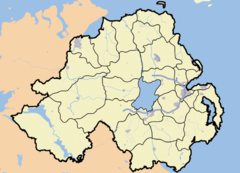Belcoo
| Belcoo | |
| Irish: Béal Cú | |
Belcoo shown within Northern Ireland | |
| Coordinates: 54°17′46″N 7°52′16″W / 54.296°N 7.871°W | |
| District | Fermanagh |
|---|---|
| County | County Fermanagh |
| Constituent country | Northern Ireland |
| Sovereign state | United Kingdom |
| Post town | ENNISKILLEN |
| Postcode district | BT93 |
| Dialling code | 028 |
| European Parliament | Northern Ireland |
| UK Parliament | Fermanagh and South Tyrone |
| NI Assembly | Fermanagh and South Tyrone |
| List of places: UK • Northern Ireland • Fermanagh | |
Belcoo (Irish "Béal Cú" meaning "mouth of the hound") is a small village in County Fermanagh, Northern Ireland, 12 miles from Enniskillen. It is situated on the County Fermanagh/County Cavan border beside the village of Blacklion in the Republic of Ireland. It is in the Fermanagh District Council area.
The Lough MacNean Tourism Initiative has been in operation since 2003, and is an economy building project, aimed at addressing tourism needs in the area while promoting cross-border relations. Belcoo Enterprise Ltd opened in 1992 in units shared with the Belcoo Historical Society, a doctor's surgery, a chiropodist and Lakeland Community Care. The Mullycovet corn mill, which functioned from 1830 until the 1920s, is being restored. The Indigenous Resources School of Transferable Skills aims to teach marginalised groups including the unemployed, new age travellers, the disabled, to use natural materials as a learning facility.
History
The earliest mention of the village is in the old Ulster Saga "Argain Belcon Breifne" also known as "Togail Bruidne Bélchon Bréifne" (Massacre of Belcu Brefne). This tells the tale of a trap set for the great Ulster hero Conall Cernach by a Breifne chief named Belchu Brefne. However Conall manages to reverse the trap and causes Belcu's sons to kill Belcu by mistake. The place where the tale occurs was later named Belcu or sometimes Belcon in honour of Belcu. Isaac Butler in his book "A Journey to Lough Derg" written in 1740 states 'At Bell Con is a famous well called Davagh Patrick or the Holywell'. However a modern interpretation states the name of the village derives from the Irish: béal meaning mouth and cumhang or cung meaning narrowing, referring to the village's position on a narrow neck of water (river) between Upper and Lower Lough Macnean. Another often used derivation is Béal Cú i.e. where Cú is the word for hound. Hence the village name would mean the mouth of the hound. Máire MacNeill in her book "The Festival of Lughnasa", 1962, gives a local Belcoo folktale about balefire coming out of a hound's mouth before it is killed by Saint Patrick.
In his book "Upper Lough Erne", written in 1739, Reverend William Henry states, "Lough Macnane is contracted into a narrow, deep canal, in which form it flows through a flat meadow for half a mile to the redoubt of Bellcoe, where is a good ford and a new bridge across it. From the ford, the lake, expanding again, continues for three miles more". In Seamus Pender's "A Census of Ireland, Circa 1659" the village is called "Belcow". Matthew Sleater's Directory of 1806 states "Belcoo-bridge (which leads to Garison in Fermanagh County) over a river containing the two lakes called Lough Macnean, which extends along this road 6 miles".
Transport
Belcoo is situated on the A4 road from Enniskillen, at the point where it reaches the border with the Republic of Ireland and becomes the N16. Buses on the Enniskillen to Bundoran Translink route stop here.[1]
The village formerly had a small train station on the railway line servicing Sligo and Leitrim. In 1878 a stationmaster’s house and six houses were built for railway workers and their families and the following year the Sligo, Leitrim and Northern Counties Railway line opened with Belcoo station serving both Belcoo and Blacklion. The last trains ran through the station on 20 September 1957. Belcoo railway station opened on 18 March 1879, but finally closed on 1 October 1957.[2]
Notes
- ↑ "Timetables list (61-70)". Translink. http://www.translink.co.uk/present/IndexSvc.asp#61_70. Retrieved 2009-03-21.
- ↑ "Belcoo station". Railscot - Irish Railways. http://www.railscot.co.uk/Ireland/Irish_railways.pdf. Retrieved 2007-09-12.
